Many of Europe’s top leagues have been praised for their competitive title fights this season, and the Malta Premier League is no exception. Floriana FC, having finished a lowly eighth last season, currently sit at the top of the standings, boasting the second-best attack (48 goals scored) and best defence (10 goals conceded) in the league. However, they are only two points clear of top-scorers Hamrun Spartans (50 goals) with four matches to play.
Floriana are no strangers to silverware, though. The club, one of the oldest in the world having been founded in 1830, have picked up 49 trophies over the course of their 194-year history. They most recently won the top-flight title at the end of the 2019/20 season, bringing an end to a 27-year wait for a league crown. Floriana also lifted the 2021/22 Maltese FA Trophy while winning the Maltese Super Cup in the 2017/18 campaign. However, they have had a mixed bag of results in the league across the last decade. Apart from their title win, Floriana finished ninth in 2012/13, eighth in 2014, fifth every season from 2014 to 2018, eighth in 2018/19, 12th in 2020/21 (their first season after winning the title), second in 2021/22 and eighth last season. They notably competed in the UEFA Europa Conference League last term, losing out in the first round of qualifiers.
This season, however, they look back to their best under Juventus legend Mauro Camoranesi. Their attacking exploits, in particular, are driven by effectiveness in counterattacks and quick passing moves. This tactical analysis report will analyse both of those aspects and Camoranesi’s tactics in detail.
Background
Camoranesi largely enjoyed a journeyman career that saw him play for Santos Laguna, Wanderers, Banfield, CD Cruz Azul and Hellas Verona from 1994, when he began his senior career, to 2002. He then joined Juventus and enjoyed an eight-year spell with the Italian giants, recording 32 goals and 74 assists in 282 matches while winning Serie A, the Coppa Italia and two Supercoppas de Italiana. The Italian called time on his playing career in 2014 after short spells at VfB Stuttgart, Lanús and Racing Club. Camoranesi also won 55 caps for Italy and played his part in their 2006 FIFA World Cup victory.
He got into management in January 2015 with a seven-month spell at Coras de Narayit in Mexico, guiding them to seven wins in 24 matches. In December that year, Camoranesi joined Tigre, but lasted just seven games and was let go off in March 2016. He was back in a job five months later at current Mexican third-tier side Cafetaleros de Chiapas, but once again, his spell was short-lived as he oversaw them to just four wins in 14 matches before they parted ways. This was followed by slightly longer spells at Tabor Sezana (eight months) and NK Maribor (nearly six months) before his first assistant manager job with Olympique Marseille in July 2022, which unfortunately lasted just eight days.
Camoranesi was then appointed by Floriana in June last year and it has already given him the longest tenure at a club so far in his managerial career.
Key Statistics to explain Floriana’s improvement in attack
Last season, Floriana scored 30 goals in 26 matches (1.22 per game) and generated 1.57 expected goals (xG) per game in the Malta Premier League. They averaged 13.91 shots (34.4% on target), 6.61 shots from outside the box (28.3% accuracy), 430.17 passes (79% accuracy) and 54.94% possession per game.
Most of these have experienced upticks this season. Under Camoranesi, Floriana are averaging almost the same number of shots (13.86), but are shooting better (41.1% on target). A key reason for this is their reduced attempts from outside the penalty area (5.36 with 28% on target). Expectedly, their goals per game has improved to 2.18, a slight overperformance on their xG of 2.03.
A look below at the comparative shot map shows that Floriana are now taking quite a few more shots from well inside the penalty area, leading to higher-quality chances. The only real downer on their performance is their record from penalties, as they have scored just six of their 11 spot-kicks this season.
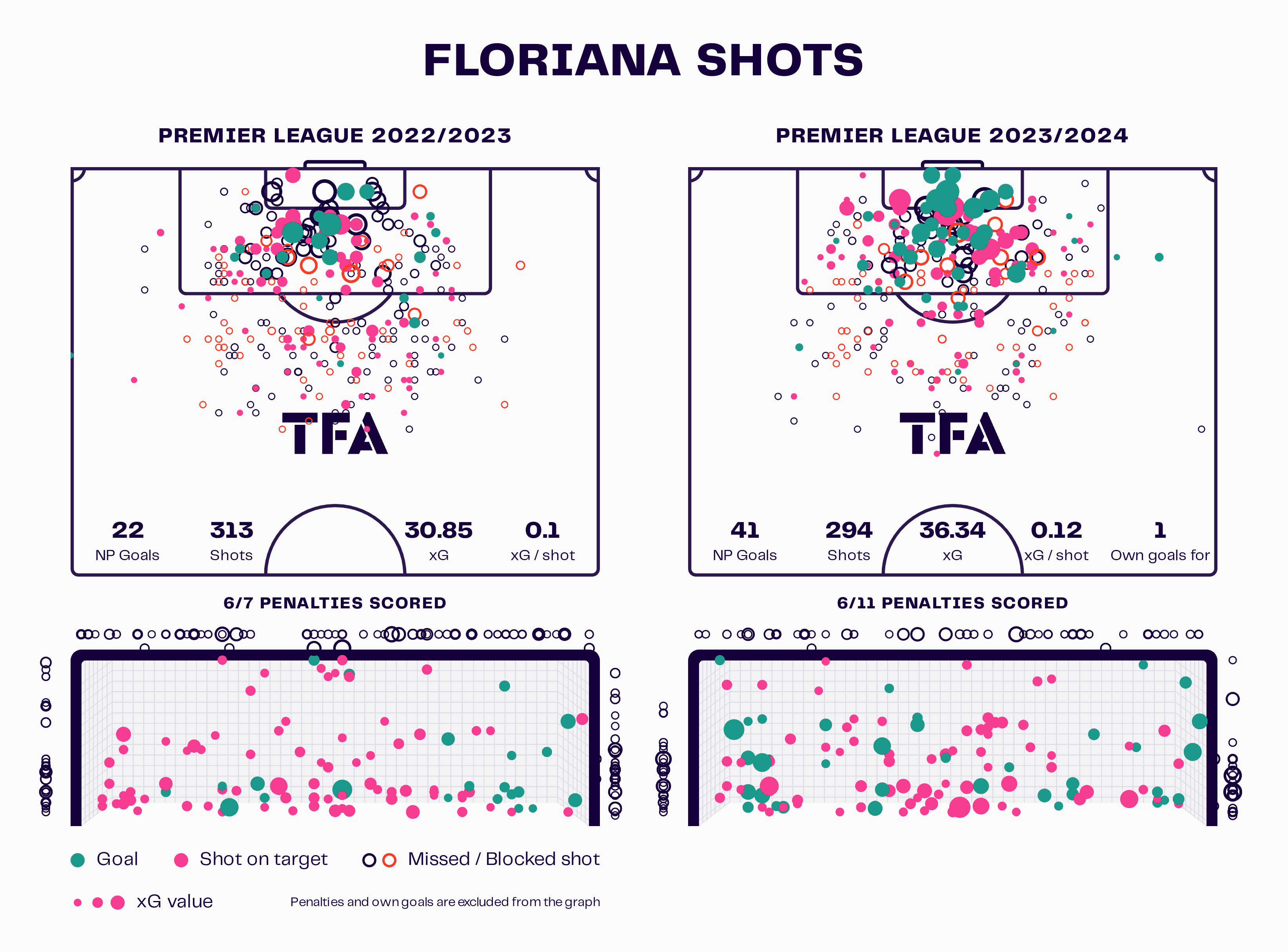
They are passing only 375.64 times per match with a similar accuracy (78.2%), while their possession percentage has come down to 52. Their positional attacks per game have dropped from 35.7 to 33.6, as have their set-pieces (32.35 to 27.36) and corners (6.43 to 6.32). However, the Greens are getting marginally more shots from all three attack types this season, thanks in no part to their improved passing, which we will explore soon.
Floriana have replaced the need to depend on these attacks by simply becoming a better counterattacking side. Their average counters per game has gone up to 1.73 per game from 1.39 last season, with 44.5% of those counters resulting in a shot. This has made it the most productive attacking outlet for Camoranesi’s men this term.
Floriana’s Pressing
Floriana is not afraid to commit men forward when they counter, and a key driver of their newfound ability is a more robust pressing system. Under Camoranesi, their passes per defensive action (PPDA) figure dropped to 6.76 (from 7.80) last season. Below is an example of how they press opponents high up the pitch from their match against Valletta.
At the start of the move, Floriana have only three players in the opposition half against five for Valletta. However, by the end (and after a lucky penalty escape for Valletta), we see five Floriana players stuffing up the spaces by closely marking five opponent players. Valletta are forced to boot the ball forward.
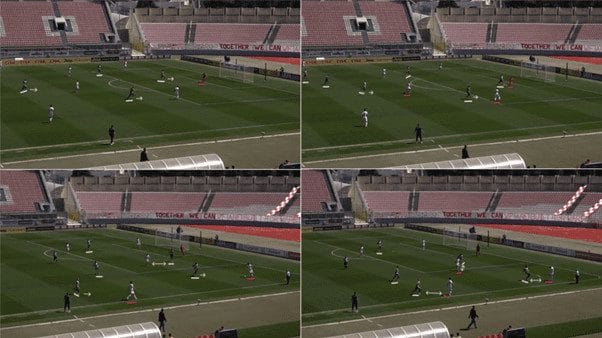
As the map below shows, Floriana have been aggressive pressers this season, with multiple dangerous recoveries (leading to a shot within five seconds of winning the ball) in and around the box.
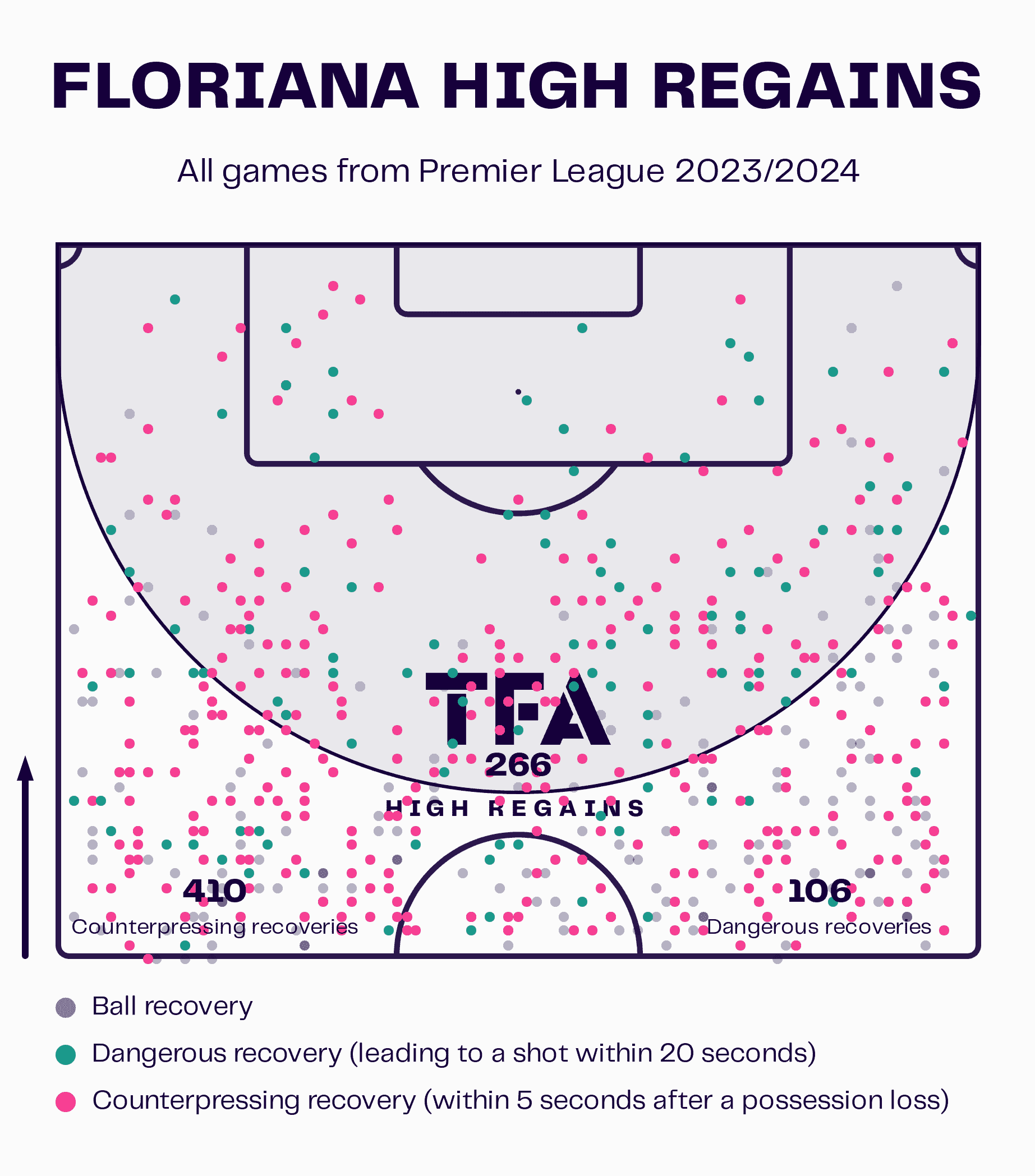
This then sets them up well to win the ball in the final third, or even near their own half, and swiftly hit teams on the counter. It also help Floriana to punish opposition errors.
Goals on the counter
Floriana’s goalscoring load in the league has been spread across the squad this term. Kemar Reid leads the line with 13 strikes in 20 league games, while Mattia Veselji and Willis Furtado have scored five times. Matheus Souza and Ulises Arias have netted four goals each, while Oualid El Hasni has three. Three more players have two league goals each, while eight have scored once apiece.
In particular, Reid has proven to be a threat on multiple levels — an aspect we will touch upon later — and one of those is by aiding the press and adding the finishing touch to moves close to the area. Consider the sequence below from Floriana’s match against Sliema Wanderers, where they win the ball near the box and feed the Malta international, who finishes with clinical precision. The move is also an excellent example of the intricate passing this team is capable of, as a quick one-two sends Reid one-on-one with the goalkeeper.
The Valletta manager’s reaction on the bottom right of the top-right and bottom-left panel screams volumes of how aware opposition coaches are of Floriana’s threat when they win the ball that high up on the pitch.
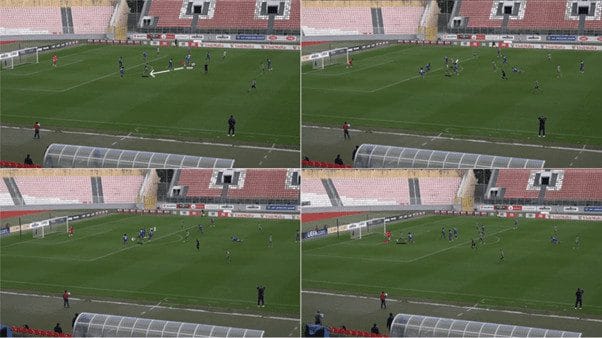
Another excellent example of Floriana’s ability on the counter is the goal below by Souza against Sirens. Here, they deploy a different strategy by baiting the centre-back into carrying the ball forward. He then sees the nearest pass receiver (who has his hand up to ask the defender to pass elsewhere) being surrounded by three Floriana players, but still attempts the pass and gives it away. The Greens then counter, once again, with some intricate passing, and Souza scores with a fabulous strike from outside the box.
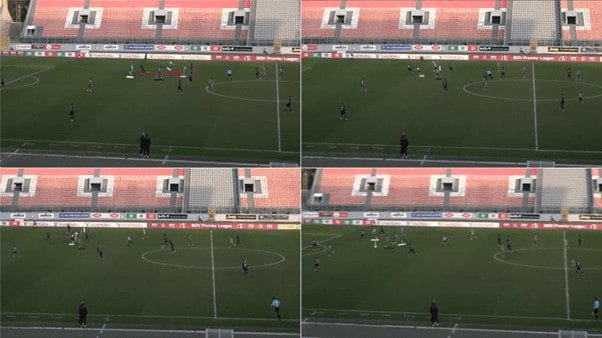
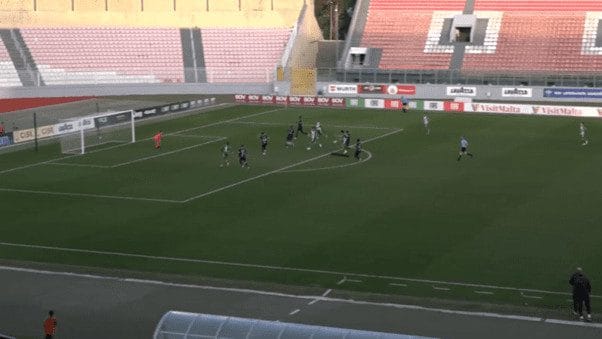
The simplest example of the lot is Floriana’s goal against a tired Valletta side, scored by Jake Grech. Here, pressure from behind helps dispossess the opponent and with the team pushing men forward as they are a goal down, and a simple slide-roll pass slips in Grech, who takes the chance with aplomb.
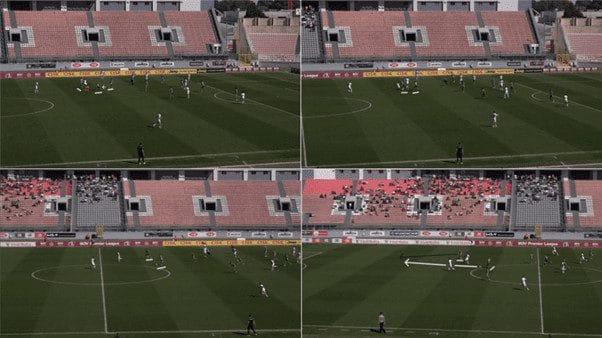
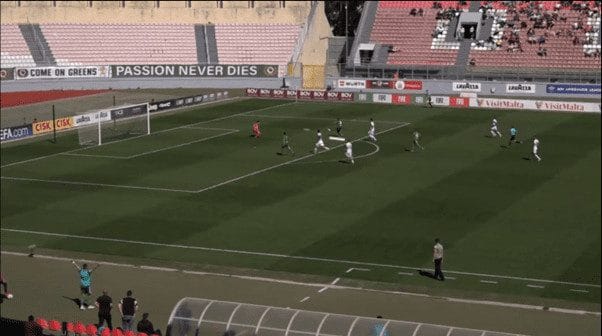
In this way, Floriana have found a way to combine their high press with swift movement and crisp passing to get into positions of maximum opportunity on the counter. Their clinical finishing has undoubtedly helped as well.
Alternate Avenues
Counterattacking is the central theme of Floriana’s offence under Camoranesi. However, they have also been a threat from long passes (49.45 attempts per game with 51.2% accuracy, as indicated by this goal by Reid in their Maltese FA Trophy tie against Zebbug Rangers. Here, he expertly brings down a ball forward from the defence before rounding the goalkeeper and finishing into an empty net.
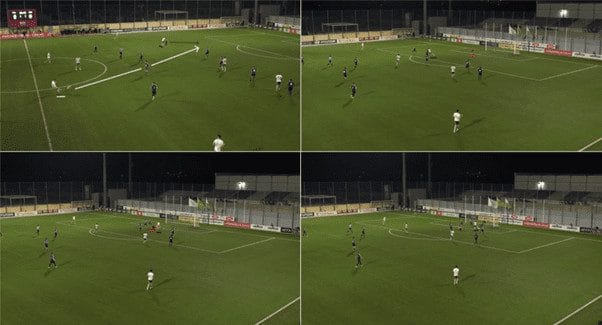
Their ability to pass both quickly and short as well as accurate and long means Floriana are a threat on multiple levels. While they are yet to fully utilise the power of their quick passing from positional attacks, it is certainly something they seem to be working on based on the evidence from their counterattacks.
Conclusion
Under Camoranesi, Floriana has transformed into a well-oiled attacking machine fueled by counterattacks, which are, in turn, initiated by a fantastic pressing system. These two remain their main avenues of attack, though they also pose threats from alternate forms of attack and should only get better if the Juventus legend is given more time at the helm.
With four games to go, Floriana will be confident of their chances of reclaiming the Malta Premier League title.





Comments